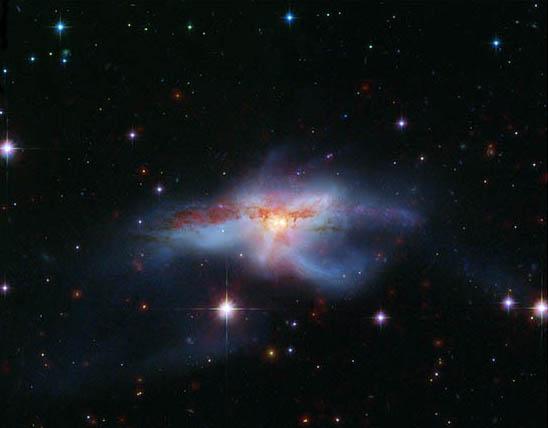
A pair of colliding galaxies as seen in the infrared and optical in a rare, short-lived phase of their evolution just before they merge into a single, larger galaxy. New SMA observations of similar colliding galaxies in the early universe concludes that these interactions produce short bursts of star formation that light up the galaxies.
Astronomers using new submillimeter wavelength telescopes discovered, about a dozen years ago, the existence of a new class of very distant galaxies. These objects are located so far away that their light has been traveling towards us for over ten billion years - more than 70% of the lifetime of the universe. Although today they are old, we see them as they were only a few billion years after they formed, when they and the universe they lived in were relatively young.
These galaxies were undetected in the visible but emit strongly at submillimeter wavelengths because they have an abundance of warm dust. What heats the dust is still controversial - probably either massive star formation, or an active black hole at the galactic nucleus, or perhaps both. Our Milky Way galaxy, or at least the region where the sun resides, probably formed between seven and ten billion years ago, and so understanding these remote systems can also help us understand our own origins.
CfA astronomers Giovanni Fazio, Matt Ashby, Francesca Civano, Mark Gurwell, Jia-Sheng Huang, Glen Petitpas, and Dave Wilner, led by a recent CfA graduate student (now a postdoc) Josh Younger, together with five colleagues, used the Submillimeter Array (SMA) to probe the emission in two of these puzzling, luminous galaxies. The spatial resolution of the SMA allowed the team to measure the substructure of the bright cores for the first time. That structure holds the key to understanding the physical processes at work.
Writing in the latest issue of the Monthly Notices of the Royal Astronomical Society, the scientists present their conclusion: the luminous nuclei are most probably the result of bursts of star formation caused by a recent collision with another galaxy. Two alternative explanations that had been popular, gas-rich discs that feed active star formation or active black hole nuclei, are both less likely than interaction scenario. The SMA results and the new study's conclusions mark an important advance in deciphering the nature of galaxies in the early universe.